The Green Funnelled Kiwi Fleet

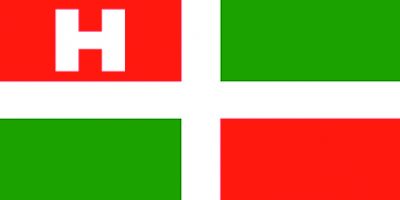 This company was first registered on 3rd December 1926 to bring together two small steam coasters trading on the coast, and a four masted American built schooner bringing coal cargoes across the Tasman Sea to Wanganui, and all previously registered under separate companies. The Holm Shipping Co. Ltd. was to last for over fifty years and become famous in the South Pacific trades, to Norfolk Island, and as a lifeline to the Chatham Islands, 467 miles east of South Island, and the Kermadec Islands, 650 miles north of Auckland, as well as the occasional charter to the Australian National Antarctic Research Expedition (ANARE) for Antarctic supply voyages. During the 65 years of trading, all of the owned vessels had a common nomenclature beginning with ‘Holm’ e.g. Holmdale, Holmwood, Holmlea, Holmburn, Holmglen, Holmbank, Holmbrae and Holmpark. The motor coaster Holmdale of 911 grt was completed at Martenshoek in Holland in 1961 and traded for the company for thirty years between New Zealand and the Cook, Chatham and Kermadec Islands to earn herself a place in the maritime history annals of the Antipodes.
This company was first registered on 3rd December 1926 to bring together two small steam coasters trading on the coast, and a four masted American built schooner bringing coal cargoes across the Tasman Sea to Wanganui, and all previously registered under separate companies. The Holm Shipping Co. Ltd. was to last for over fifty years and become famous in the South Pacific trades, to Norfolk Island, and as a lifeline to the Chatham Islands, 467 miles east of South Island, and the Kermadec Islands, 650 miles north of Auckland, as well as the occasional charter to the Australian National Antarctic Research Expedition (ANARE) for Antarctic supply voyages. During the 65 years of trading, all of the owned vessels had a common nomenclature beginning with ‘Holm’ e.g. Holmdale, Holmwood, Holmlea, Holmburn, Holmglen, Holmbank, Holmbrae and Holmpark. The motor coaster Holmdale of 911 grt was completed at Martenshoek in Holland in 1961 and traded for the company for thirty years between New Zealand and the Cook, Chatham and Kermadec Islands to earn herself a place in the maritime history annals of the Antipodes.

Early Holm Beginnings
Capt. Ferdinand Holm was born in Arboga in Sweden in 1844 into a family of deep sea seafarers voyaging around the world, and he arrived in a sailing ship in Australia and New Zealand in 1868. He then rose to command sailing ships sailing out of Wellington and also worked as a Wellington pilot. He put aside sums of money into savings in order to become a part owner in sailing ships on the 64ths system of ownership, commanding six sailing ships between 1880 and 1915 with part, half or full shares owned. He was very much a sailing ship man, never commanding steamers, and he voyaged extensively across the South Pacific, across the Tasman Sea to Australia, and in the Indian Ocean to Calcutta, Tamatave (Madagascar), Mauritius, and the Dutch East Indies. Capt. Holm often took his wife Mary and one or more of his large family of four sons and five daughters on these voyages. Two of his sons became well respected Master Mariners in their own right, Capt. Sydney Holm and Capt. Mariner Holm, with the other two sons becoming marine engineers.
There are surviving photographs of the crew of 17 of the barque Helen Denny of 728 grt, completed in 1866 at Port Glasgow for the Albion Line of Paddy Henderson, showing Capt. Sydney Holm in command of the vessel along with his brother Mariner Holm and his daughter Phyllis. This famous sailing ship made a dozen voyages to Rangoon and the Far East before being transferred to the New Zealand trade in 1874. She then made 21 voyages to New Zealand between 1874 and 1896 and was purchased by Capt. Ferdinand Holm in 1900. He and his son Capt. Sydney Holm became joint owners in 1907 and this barque was then sold to the Paparoa Coal Mining Company of Wellington in 1913 but was withdrawn from intercolonial trade in the following year and hulked.
Capt. Ferdinand Holm at the age of 68 years purchased the British four masted barquentine Titania of 1,107 grt in 1912, completed in 1895 by Russell & Company of Port Glasgow for the New Zealand trade. Titania soon became his favourite ship of all of the sailing ships he commanded and owned, sailing her to the Pacific islands and to Australia. A voyage to Suva was made in July 1914 with Mariner Holm joining the crew here as Third Officer. After discharge of her Wellington cargo, she was routed to the French owned Surprise Island to load a cargo of guano. Capt. Holm then found he had to call at Noumea at the southern tip of the French owned island of New Caledonia to clear the ship’s papers. The French Government had given orders on the outbreak of war on 4th August 1914 to extinguish all lights in the Pacific including that at Noumea marking a ten mile reef on the entry to the port. Mariner Holm went aloft when they approached Noumea but could see no light until the masthead light of the Australian cruiser HMAS Australia was seen. Capt. Holm assumed this must be from the lighthouse but orders were then received from the cruiser to ‘stand in’ and wait until daylight. While manoeuvring to carry out these orders, Titania was swept by a huge wave and landed on the shore close to the lighthouse, and daylight showed another three sailing ships had piled onto the rocks during the night, all as a result of the French Government decision to extinguish the light. All hands were rescued from Titania with Capt. Ferdinand Holm and Mariner Holm arriving in Noumea harbour in a small boat towed by a steamer.

Hamasamicho while on a voyage from Kurosaki to Naoyetsu with a cargo of coke.
Capt. Ferdinand Holm lived at Patanga Crescent in Wellington, and only commanded one more ship in his life, the old barque Antiope, built in 1866 by John Reid at Port Glasgow and which had traded between the West Coast of America and Australasia. Mariner Holm joined her at Sydney for a voyage as Second Officer to Europe with coal, returning with timber to Sydney. When she returned to Sydney in the summer of 1915, her owners were in financial difficulties and Capt. Holm sailed to Sydney to inspect her with a view to purchase. After sailing the old barque into Wellington in September 1915, Capt. Ferdinand Holm retired from the sea and died later in 1917 at the age of 73 years.

Coastal New Zealand And Pacific Trading
The main point to bear in mind about the coastal New Zealand services of the Holm Shipping Company, the coastal businesses of Capt. Alex F. Watchlin, Richardson & Company of Napier, and the Canterbury Steam Shipping Co. Ltd. is that they were controlled financially by the ‘Octopus’ of the Union Steam Ship Company of New Zealand Ltd. (owned by P. & O.) from 1933/34, although remaining independent. The three ship fleet of Capt. Alex F. Watchlin was soon broken up with the motor coaster Port Tauranga fully transferred within the tentacles of the ‘Octopus’ and renamed Kopua, while the steamers Port Whangarei and Port Waikato were chartered to Holm in 1938/40, with Port Whangarei later renamed as Holmburn in 1944. The main Holm coastal service was from the West coast of North Island ports of Port Waikato, New Plymouth, Wanganui and Wellington to the East coast of South Island ports of Lyttelton and Dunedin.
However, all of the coastal services of the four companies mentioned were redundant with the advent of the ro-ro services of the New Zealand Government Railways in 1961 between Picton and Wellington. Aramoana, Aranui, Arahanga and later Government owned ro-ros of the 1970s allowed freight lorries to run the length of the two islands without transshipment and spelled the end of traditional New Zealand coastal services. P. & O. representatives visited New Zealand and interviewed everyone connected with the operation of the ‘Octopus’ and the independent coastal companies such as Holm, and quickly summed up the situation and suggested that the coastal fleets of Richardson & Company of Napier and the Canterbury Steam Shipping Co. Ltd. should be bareboat chartered to and integrated into the Holm fleet in 1969. The Holm staff were trimmed and Capt. John F. Holm, the Managing Director and grandson of the founder, retired with the Holm Shipping Co. Ltd. becoming a wholly owned subsidiary of the ‘Octopus’ from 1st October 1969.
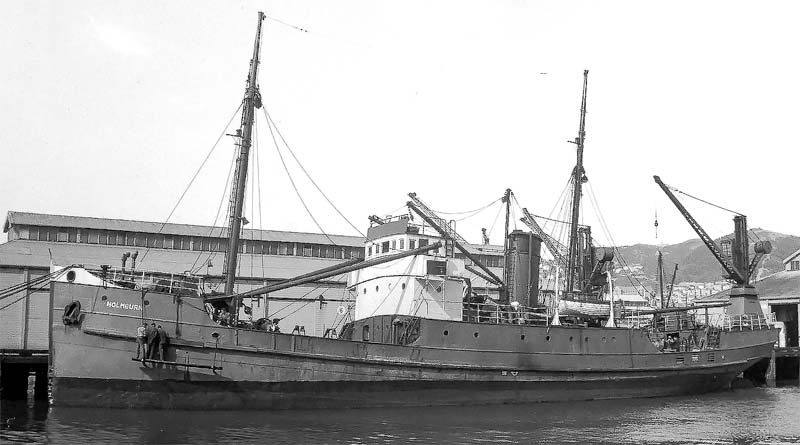
The Head Office of the family business from 1917 and the home of Capt. Sydney Holm was in Whanganui on the Whanganui river, the longest navigable river in New Zealand, and which began to be settled with colonists in 1840 on Maori land. The cargo river traffic at the Town Wharf of Wanganui has long gone, and today only riverboats operate for tourists. The Head Office was later moved to Wellington where Capt. John F. Holm and other members of the family lived at Worser Bay in the eastern suburbs of Wellington and facing the sea. Today, Wellington International Airport and the thriving New Zealand film studios are based at Worser Bay. The Holm Shipping Co. Ltd. also had the contracts to supply Port Waitangi in the Chatham Islands from 1938, as well as later services to the South Pacific islands. Cargo for the Chatham Islands was loaded up at Lyttelton, Gisborne, Napier, Tauranga, Dunedin, Timaru, Oamaru and other East coast ports, with sheep, goats and cattle for the return voyage loaded from nine different anchorages in the two islands, Chatham Island and Pitt Island, over a two week period. The animals were loaded from corrals up wooden gangplanks to the weather deck.
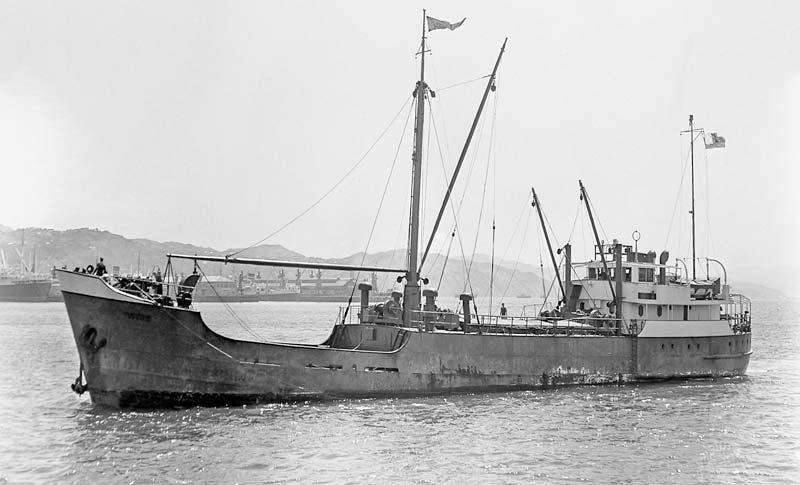
Hamilton is the fourth largest city in New Zealand and the largest inland city and stands on the mighty Waikato river, the longest river in New Zealand of 264 miles in length. The now disused wharf at Port Waikoto is near the seaward end of the river and is twenty miles south of Manukau harbour of western Auckland. Holm Shipping used Port Waikato from 1926 and ran services southwards to South Island for fourteen years until the bar began to silt over. Two of the original steam coasters of the Holm Shipping Co. Ltd., John of 342 grt built in 1899 at Whitby by Turnbull & Son and usually commanded by Capt. Sydney Holm, and Progress of 244 grt built in 1882 at Port Chalmers, were able to negotiate the bar with ease and maintain a fortnightly service.
However, Progress broke her tailshaft in the Cook Strait while on a voyage from Lytttelton to Wellington on 30th April 1931 and despite attempts to hoist sails she struck the rocks at Ohiro Bay near Wellington and broke up. A replacement was found in Europe in the Dutch built Baltic trader Argus of 448 grt and 560 dwt, and she arrived in New Zealand at the end of 1931 with a cargo of bitumen loaded at Trinidad. She was renamed Holmglen and traded for the Holm Shipping Co. Ltd. for twenty years. Another steam coaster built at Goole as Glenside in 1921 and formerly in the fleets of the Glenside Steamship Company of Middlesbrough and the Firth Shipping Company (Gillie & Blair) of Newcastle was purchased in 1936 and renamed Holmlea for the Port Waikoto trade. This port closed in 1940 and operations were transferred to Raglan harbour, thirty miles to the south, with lorries moving cargo the last few miles to Hamilton.
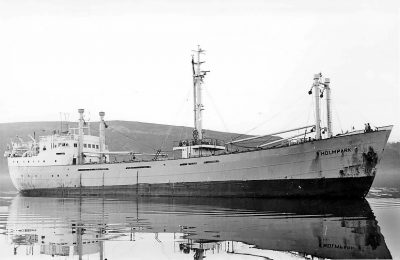
The larger steam coaster Holmdale of 681 grt and sold on the stocks to Capt. Sydney Holm in 1921 at the Dublin yard of Dublin Shipbuilders Ltd. was too big for the Port Waikoto trade and was used from Wanganui to the South Islands ports of Lyttelton and Dunedin. By chance, a sister of Holmdale with the same hull dimensions was completed in 1929 by the Henry Robb yard at Leith for Capt. Alex Watchlin but was fitted with an American four cylinder diesel engine by Fairbanks, Morse & Company of Chicago. Port Waikoto was taken on charter by Holm in 1940 for the Chatham Islands service after Holmwood had been sunk by the German raider Komet shortly after her purchase in 1940. Holmdale was also converted into a motor coaster in 1937 when an Atlas diesel of 725 bhp was fitted. Thus, two identical raised quarterdecker motor coasters with bridge ‘midships and a tall steam funnel aft and two derricks on two masts for cargo handling were part of the Holm fleet in 1940 as Holmdale and Port Waikoto.
The Holm fleet on the outbreak of war on 3rd September 1939 consisted of three coasters, Holmlea, Holmglen and Holmdale, as well as the small motorship Port Whangarei chartered from Capt. Alex F. Watchlin. The latter motorcoaster of 506 grt had her bridge and engines ‘midships with a motorship funnel and had been built back in 1906 at Bremerhaven as a steamer. She had been converted into a motorship in 1932 with twin Fairbank-Morse diesels fitted shortly before her purchase by Capt. Alex F. Watchlin. She was renamed after the most northerly city in New Zealand as Port Whangarei and 43 miles north of Auckland. Today, the huge oil refinery at Marsden Point is nearby and is the largest in the country. Port Whangarei traded down the east coast of New Zealand between Whangarei and Dunedin until chartered in 1938 for the Chatham Islands trade. On 30th October 1942 she was requisitioned by the New Zealand Navy and under her Navy name of KG28 she carried supplies to American forces in the Pacific, based mainly in New Caledonia.
Holmlea also served her country during the Second World War, being requisitioned to carry coal from the west coast port of Greymouth on South Island to North Island ports. Holmglen and Holmdale remained on their Wanganui to Dunedin service during the war, with Holmdale twice briefly aground at her northern terminus of Wanganui. The Holm Shipping Co. Ltd. did suffer a war loss to enemy action, this was Holmwood purchased on 1st August 1940 for the Chatham Islands service. She had been built at Goole in 1911 as Tees of 546 grt for Edward P. Hutchinson of Hull and had come out to New Zealand in 1922 on her purchase by a Greymouth owner for the coal trade and under Government contract to supply the Chatham Islands. She had her bridge and engines ‘midships and made one return voyage for Holm to the Chatham Islands and on her return was given an extensive two month refit with repairs and some alterations carried out.
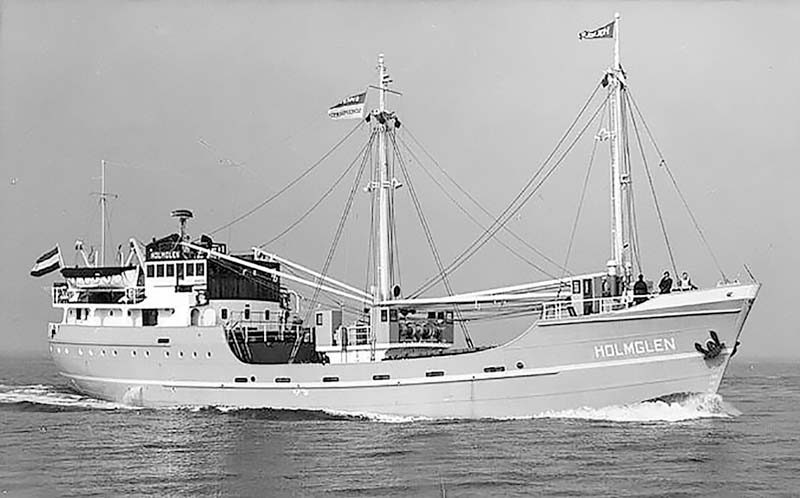
The 485grt Holmglen was built in 1956 by G. & H. Bodewes at Martenshoek. On 24th November 1959 she sank 22 miles south-east of Timaru with the loss of all hands.
Holmwood loaded 1,375 sheep and several tonnes of general cargo and bales of wool and twelve passengers for her return voyage on 25th November 1940 from the Chatham Islands to Lyttelton, a voyage of 520 miles. Two days later, she was intercepted by the German raider Komet, with a boat sent over from the raider at 0700 hours. All of her crew of seventeen including Capt. Miller, Chief Engineer Abernethy and the twelve passengers were transferred to the raider and Holmwood was sunk by gunfire. Komet was acting with the raider Orion and together they sank another six ships including the large liner Rangitane before all of the 496 captured prisoners were released on Emirau Island in the Bismarck Archipelago on 21st December. Six days later, the steamship Nellore arrived to end their sojourn and took them to Townsville in Queensland. The Holmwood crew and passengers voyaged home from Sydney to Auckland on the American liner Mariposa.
New Post-War Motorships
Four new motorships were built in Holland between 1952 and 1961, none of which were sister ships, although Holmwood (3) of 1,030 dwt was very similar to Holmdale (2) of 1,080 dwt with bridge ‘midships and engines aft and nine derricks on two masts and two sets of posts, one set in front of the bridge and the other set behind it. The other pair of new motorships were of the ‘all aft’ design, with Holmglen (2) of 500 dwt being specially strengthened for Antarctic work and fitted with the most modern navigation and safety equipment, and the larger Holmburn of 1,060 dwt and fitted with ten derricks on one mast and two sets of kingposts, one set being in front of the bridge. They traded from Whanganui at the mouth of the Whanganui river, New Plymouth with the dramatic backdrop of Mount Taranaki, a snowcapped, dormant volcano of 8,260 feet in height and known as ‘Mount Fuji’ of New Zealand, and Wellington to Lyttelton, Timaru and Dunedin, the ‘Edinburgh of the South’ due to its Scottish population. The route was extended northwards to Onehunga from 1957.

However, the first of the post-war motor vessels was purchased second hand in 1950 as Speedwell of 792 dwt from a Haarlem owner having been completed in that Dutch town four years earlier. She was renamed Holmlea (2) and she arrived in Wellington on 6th January 1951 to take up her regular service between Raglan on North Island and Dunedin on South Island. She also made one voyage every year to the Chathams during the wool season, and also to Norfolk Island, as well as to Campbell Island in the remote sub Antarctic and Raoul Island in the Kermadecs on charter to the New Zealand Civil Aviation Department for supply missions to these two meteorological stations. She made a nine day voyage in March 1954 under the command of Capt. John F. Holm, grandson of the founder, to remote Macquarie Island, 750 miles to the south of Bluff on charter to ANARE. She sailed from Wellington at 1900 hours on 19th March and arrived at the Auckland Islands, halfway to Macquarie Island three days later, landing scientists and their gear and supplies including food for three weeks. Land was sighted on 17th March that turned out to be the Judge and Clark Islands eight miles to the north of Macquarie Island. Supplies, cargo, mail and scientists were landed at Hasselborough Bay on the twenty mile long island, with one sick scientist taken off during a six hour visit. After a return visit to Enderby Island, Disappointment Island and Rose Island in the Auckland Islands, Holmlea resumed her return voyage to New Zealand and arrived at Dunedin at 1100 hours on 21st March.
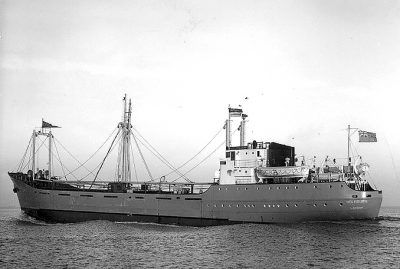
Holmwood (3) was the first of the four new motorships to arrive from the Martenshoek yard of Bodewes Scheepswerven. She left Holland for London under the command of Capt. Sydney Holm on 28th January 1953 and loaded cement for Haiti. She then crossed the Caribbean in ballast to load bitumen at Trinidad for Wellington and arrived there on 18th April 1953. She remained on her main route from Raglan to Dunedin for all of her career except for one voyage to the Chathams during the wool season. The ports served varied and were extended to Onehunga (Western Auckland) with Lyttelton and Timaru mostly preferred to Dunedin by the end of her nineteen year Holm career.
Holmglen (2) was designed for servicing the Campbell and Raoul Islands weather stations after her arrival from Martenshoek in Lyttelton on 23rd May 1956. She had loaded cement at London and refueled at Curacao on her way to the Panama Canal, encountering a cyclone with Force ten winds three hundred miles south of Tahiti. Campbell Island is a remote uninhabited sub Antarctic island with an automatic weather station located at 52º 32′ South, 16º 9′ East. In March 1957, she set off on a voyage to the weather station at Raoul Island to the North of New Zealand, but a strong easterly wind prevented normal unloading and supplies were landed on a convenient set of rocks. Then on her way to Norfolk Island, she was recalled to Raoul Island to take off an injured weather scientist, and even at Norfolk Island the wind made the unloading of seven hundred drums of petrol and general cargo hazardous. The anchor cable was sheared off in the coral but eventually she returned safely to Wellington ploughing through heavy seas whipped up by the strong easterly winds. The loss of Holmglen (2) on 24th November 1959 remains a mystery to this day, with all of her crew of fifteen lost some 25 miles off Timaru while on a voyage from Oamaru to Wanganui with general cargo. Capt. J. Regnaud had sailed earlier that day but sent out a Mayday at 2115 hours saying ‘they were in serious distress, heeling hard over to port and shipping water’. Several bodies were later recovered amongst the many pieces of wreckage including one upturned lifeboat. All remaining three Holm vessels altered course and laid wreaths over the wreck, and the official Court of Enquiry found that the cause was ‘still unknown’. The year of 1959 was made worse by the serious fire on Holmburn and the death of Capt. Sydney Holm, with Capt. John F. Holm taking over as Managing Director.
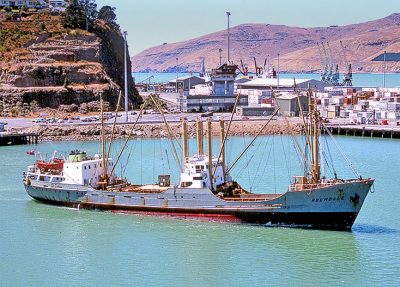
Holmburn (2) arrived in New Zealand from Holland at the beginning of 1958 and entered the coastal service as well as to the Chatham Islands. She had two refrigerated compartments, a heavy derrick of 18 tonnes capacity, and separate tanks for the carriage of fuel oil to the Chathams. She could carry over 2,500 sheep or 600 cattle plus twelve passengers in good accommodation at a service speed of 14 knots to the islands. She was equipped with removal deck fittings for the livestock cleaning operations en route, but later in her career live animals were no longer carried with frozen mutton, lamb and crayfish carried in refrigerated compartments. Holmdale (2) had much larger refrigerated capacity and she replaced Holmburn on the Chathams run. Unfortunately, Holmburn was badly damaged in a fire at Lyttelton on 7th May 1959 with the loss of both her Master, Capt. Derek Crabtree, and her Chief Steward Allan J. Hempstalk. The fire had raged for over four and one half hours during the night with the bridge and all of the Captain’s quarters completely burnt out and the remainder of the accommodation for 17 crew and a dozen passengers completely destroyed on the starboard side. The Chief Officer was awarded a citation for gallantry from the Royal Humane Society for efforts in trying to save the Master and Chief Steward. Holmburn was repaired at Lyttelton to resume her coastal service.
On another return voyage from the Chathams on 10th April 1961, Holmburn was disabled for four days without power until repairs were carried out, and in the following year she was aground broadside onto the coast at the Raglan bar while carrying a full general cargo in her holds and a deck cargo of vehicles and excavators. Holmburn sailed from Onehunga in May 1965 on the first of the new Holm services to the Pacific, this one was to Caledonia via Norfolk Island, but these regular Pacific services only lasted until 1968.
A resurgence and increase in Holm coastal trading during 1962/64 required a further two motor coasters to be chartered and then purchased. Turihaua of 665 dwt came from Richardson & Company of Napier and was renamed Holmbank, and River City of 430 dwt came from the Wanganui Shipping Co. Ltd. and was renamed Holmbrae. The latter coaster proved too small for the trade when it was extended from Raglan to Onehunga and she was sold in 1966 for New Hebrides trading. Holmbank only traded for Holm for eleven months, as on a voyage from Timaru to Wellington with 400 tonnes of general cargo, she ran aground on the Banks Peninsula at Peraki Bay on 21st September 1963. She was held fast on a rock pinnacle and quickly broke her back in the fast current with four holes in her double bottom, and she sank 36 hours later with her cargo strewn along the southern shore of the Banks Peninsula.
The Final New Motorship – Holmdale Of 1961
This ship sailed for thirty years around the South Pacific, and the remote New Zealand islands, as well as on North to South islands service, and deserves a separate section. She was launched sideways into an arm of the Winschoter Diep on 29th June 1961 at the Martenshoek yard of Bodewes Scheepswerven, exactly a year after Capt. John F. Holm had placed the contract. Trials were run off Delfzijl and she loaded firebricks and cement at Glasgow and Liverpool and arrived at Whangarei on 18th January 1962. Violent Bay of Biscay gales had smashed windows in the winchdrivers shelters and buckled some deck plates protecting deck piping. She then sailed south from Whangarei to load peas at Napier for Wellington and on to Lyttelton and Dundedin, arriving at her southern terminus on 27th January 1962.
She was a handsome ship with rounded superstructure and streamlined green funnel, good crew accommodation and a good array of two masts, two sets of posts and nine derricks, all buff coloured, to work her two holds. She had a service speed of 12.5 knots from a 1,250 bhp MaK diesel, and was faster than most of her competitors on the Dunedin to Onehunga route. The average passage from Godley Head, Lyttelton to Manukau bar outside Onehunga was 36 hours but on one occasion she arrived in under 34 hours. The main hold ran underneath her ‘midships bridge and was served by two hatches with steel covers, while a smaller hold aft with ‘tween decks was used for refrigerated cargo and was covered with heavy beams and tarpaulins to keep it watertight. This freezer hatch aft had a capacity of 110 tonnes of frozen mutton, lamb and crayfish. In April 1967, she sailed from Onehunga to begin a new Holm service to Rarotonga and the Cook Islands after the ending of the Trans Pacific service of the ‘Octopus’. However, the service ended a year later and she made only two more visits to Rarotonga in her long career. She made the last commercial sailing from Oamaru to the north of Dunedin on 14th May 1974. Oamaru became prosperous in the 19th century from refrigerated meat shipments to Europe, and it has imposing buildings from that period.
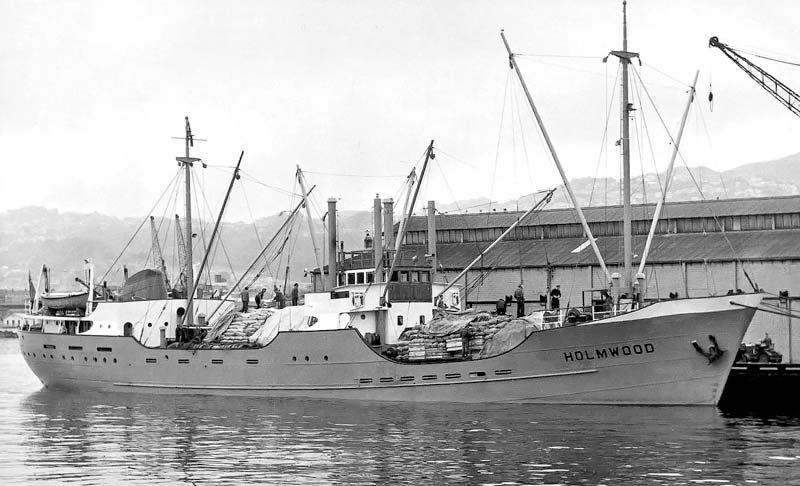
The reason for her fame was her long 22 year career as the supply ship for the Chathams from 1969 to 1991. She carried everything that was required by the islanders, from diesel for their fishing boats to everyday and luxury items such as medical supplies, cars, lorries, oxygen bottles and industrial gas cylinders, vegetables, drinks, hammers, nails, horses, cattle, pets, fishing boats up to thirty feet in length, petrol, and kitchen sinks and household utensils and a million and one other things needed by the islanders. On the return voyage she carried frozen meat, lamb, crayfish and bales of wool as well as up to twelve passengers. In fact, a typical annual trading pattern of this last owned Holm coaster showed that she was contracted to make ten voyages with supplies to the remote community of Chatham Island and its sister Pitt Island, and either laid up at Lyttelton for the rest of the year or had time for two voyages from Onehunga to Suva (Fiji), Nukualofa (Tonga) and Apia (Samoa), or to Rarotonga, or on the main North to South Islands cargo route before it virtually ceased in 1974.
After a two day passage to Chatham Island, Holmdale used extensive anchor, doubled rope and heavy wire moorings at Waitangi as she worked cargo on a very exposed wharf. Sea watches were maintained while berthed, and she would often move off to one of nine other sheltered anchorages in very bad weather. After an average of a one week stay at Waitangi, she moved south to the sister Pitt Island on two of her ten annual contracted voyages to work similar cargo for another two days. In 1978, she shipped all of the construction equipment, steel and cement, and a detachment of the NZ Army Corps of Engineers to build better bridges and roads on the island. The wharf piles at her exposed unloading berth were renewed in 1989/90, and she also carried over one thousand timber poles for carrying new power lines during this time. Surfboats, helicopters and amphibious vehicles were constantly in use to bring cargo to Holmdale at these two very remote and exposed islands that were constantly lashed by westerly Pacific and southerly Antarctic gales.
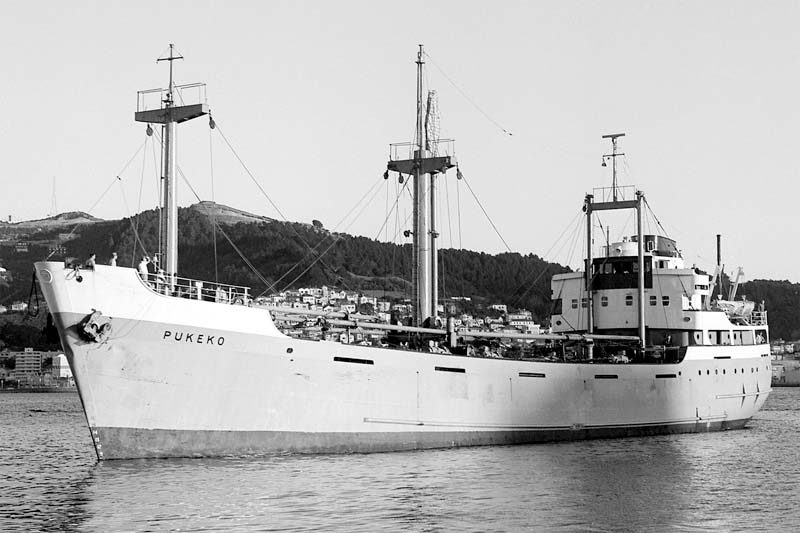
The Final Years
The Holm Shipping Co. Ltd. became a wholly owned subsidiary of the Union Steam Ship Company of New Zealand Ltd. on 1st October 1969. It had achieved its greatest ever numerical strength of thirteen owned and chartered ships by the end of the year. Four Holm motor vessels were owned in Holmwood of 1952, Holmburn of 1957, Holmdale of 1961, and Holmpark of 836 dwt, purchased in 1965 from French Line as Commandant Milliasseau. The latter ship had been designed as a Caribbean feeder ship for service between Martinique and French Guiana. She had been built at Hamburg in 1953 as an engines aft coaster with a good array of derricks on a centrally placed mast and two sets of posts. She had a barely noticeable fo’c’stle and a good service speed of eleven knots from an eight cylinder Mirlees diesel manufactured in Stockport. She was purchased by Holm in January 1965 and her name was shortened to Command under the Dutch flag for the voyage from the Caribbean to New Zealand.
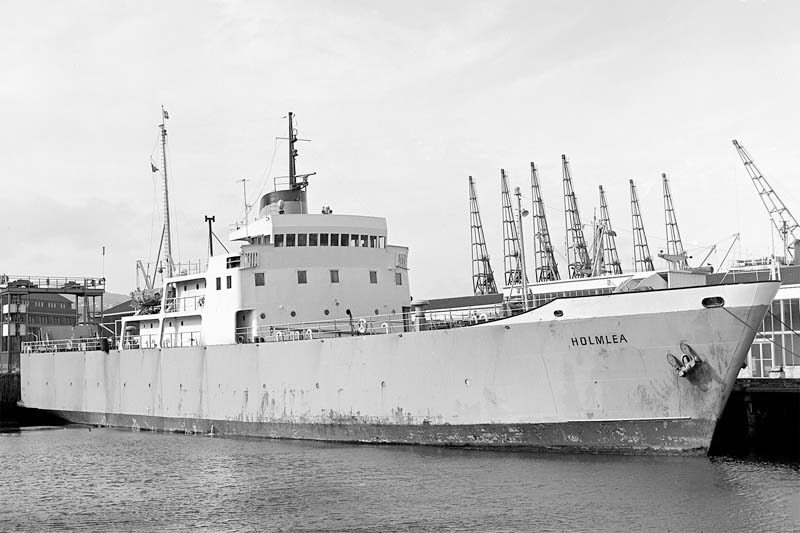
Richardson & Company of Napier and the Canterbury Steam Shipping Co. Ltd. each transferred three motor vessels under bareboat charter to Holm as part of the P. & O. reorganization process on the coast. Parera of 1,005 dwt built in 1957 at Greenock, Pateke of 1,154 dwt built in 1954 at Hoogezand, and Pukeko of 1,280 dwt built in 1961 at Port Glasgow came from the Napier company. Calm of 995 dwt built at Glasgow in 1950, Storm of 1,314 dwt built at Glasgow in 1961, and Squall of 1,050 dwt built at Port Glasgow in 1956 came from the Canterbury company. Squall had in fact been on charter to Holm since 4th August 1967. Holmpark was engaged on salvage work on the capsized ferry Wahine outside Wellington harbour, while Holmburn traded to Noumea and Holmdale to the Chatham Islands.
After the reshuffle, the combined fleet operated to both the east and west coasts of North Island from Dunedin, Timaru and Lyttelton with the green funnels of Holm coasters seen on the east coast of North Island. The Richardson & Company east coast main route was from Auckland around the Coromandel peninsula to Tauranga, Whakatane and Te Kaha in the Bay of Plenty to Gisborne, Napier, and many open roadsteads without jetties to Wellington and east coast ports on South Island. Te Kaha was named after an important Maori chief who in 1866 along with Te Kuha and other chiefs opposed the takeover of North Island by the British in a ten year war, with their faces covered in fearsome and gruesome grey and black war paint. Tauranga has the largest and most important port in the Bay of Plenty, which is sheltered on the seaward side by Matakana Island and to the west by the Kaimai Ranges. Whakatane was an important whaling and fishing port and has a Maori name, pronounced ‘Fokka-tar-nay’. Offshore in the Bay of Plenty is White Island, the most active volcano in New Zealand with eruptions every few years. Gisborne was the first part of New Zealand sighted by Capt. James Cook on 11th October 1769, however while attempting to make friends with the warlike Maoris, six of their number were shot dead on the beach, the first to be killed was called Te Maro. The area was so poor in fresh water, provisions and firewood that Capt. Cook named it the Bay of Poverty. Napier was rebuilt in 1931 after a deadly earthquake killed 258 of the local residents. The town now has beautiful Art Deco theatres, hotels, newspaper buildings, nightclubs and art galleries.
The ten owned and bareboat chartered ships all wore the green funnel with a thin black top of Holm, as did Holmlea, a ro-ro purchased on 22nd December 1969 from the Northern Steamship Company as Seaway Princess. This latter purchase was very much a move to take some ro-ro cargo away from the Government owned railway ro-ros on the Wellington to Picton route, with Holm providing a service on their traditional route from Onehunga to Dunedin. Also, a refrigerated motorship had been chartered in early 1969 from Hamburg owners for a service across the wide Pacific to Rarotonga, Tahiti and the Ecuador coast. Pagensand of 1,082 dwt was built in Germany in 1966 with a very good array of derricks on two masts. She began her charter in Cyprus by loading a full cargo of cased oranges for Auckland and Lyttelton. She had a fast service speed of 16.5 knots from a MaK diesel for her long Pacific route, and she was replaced by her exact sister Luhesand in 1970 for a further one year charter. A further chartered vessel brought the total of operated ships up to thirteen.
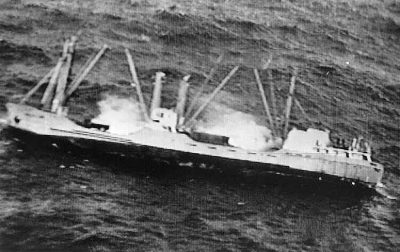
However, trade on the traditional New Zealand coastal routes began to decrease substantially as ro-ro traffic increased from 1971, and Holm agencies at many of their traditional ports were transferred to the Union Steam Ship Company of New Zealand Ltd. On 1st March 1972, the management of the Holm fleet and the bareboat chartered ships was also transferred to the ‘Octopus’. Holmwood was sold in 1971, Holmburn in 1972, Holmpark in 1972, together with three of the bareboat chartered coasters from Richardson of Napier and the Canterbury Steam Shipping Co. Ltd. in those years. The amount of available traditional coastal cargo in 1975 had been reduced to a small fraction of what had been available five years earlier, and the remaining three bareboat coasters were sold off by the end of 1975. Thus, the Holm Shipping Co. Ltd. became a one ship company until Holmdale was transferred to the ownership of the ‘Octopus’ on 23rd July 1980. Ownership of Holmdale was later transferred to Union Shipping NZ Ltd. on 27th May 1988 while remaining on a long term Government charter to the Chatham Islands.
The colourful Holm houseflag of a red and green quartered flag with a white ‘H’ on the top red quarter would never be seen again. The company had diversified into Holm Travel until it was sold in 1969, and Holm Agencies serving forty international shipping companies when their ships arrived in New Zealand. Holmdale was sold to Capt. Culhane of Celtic Pacific Shipping Ltd. of Auckland just before Christmas, 1990 and was renamed Celtic Kiwi on 10th January 1991 for a proposed service between the Cook Islands and other Pacific islands from a base in Papua New Guinea. However, this did not materialize and Celtic Kiwi sailed from Lyttelton for the last time on 25th March 1991 for Auckland to begin a monthly service to Norfolk Island.
However, the former Holmdale of 1961 did not sail for much longer, as on 16th October 1991 she sailed from Whangarei with a cargo of cement for Apia in Samoa, and then returned to Auckland to load general cargo for Norfolk Island. She sailed from Auckland on 25th October 1991 but two days later she developed a serious list to starboard and was abandoned at 1917 hours that day with her crew of thirteen all safely rescued by a yacht. Celtic Kiwi ex Holmdale sank in position 31º 55′ South, 170º 57′ E to the south of Norfolk Island after a long and eventful career of thirty years.

The New Zealand Government service to the remote Chatham Islands was taken over by a tug and barge combination.
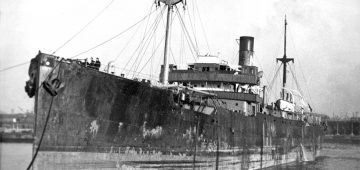



Comments
Sorry, comments are closed for this item